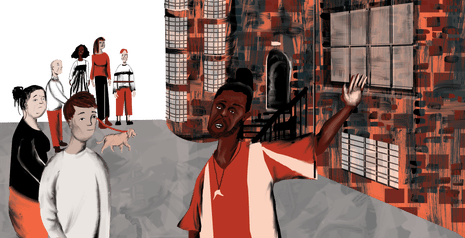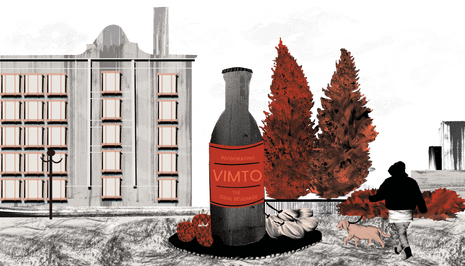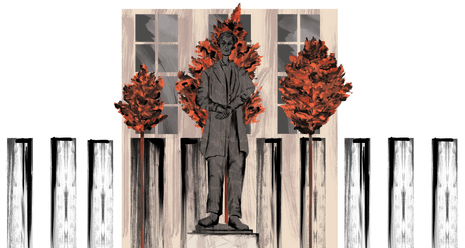WORD NEWS
A story of two cities: the battle for a Black historical past of Manchester | Manchester


On a sunny June night final yr, members of the Manchester Literary and Philosophical Society filed slowly into the Pals’ Assembly Home, simply off St Peter’s Sq.. When the neat white constructing tucked behind Manchester Central Library was constructed within the 1820s, it grew to become the bottom for the Quakers who led the abolitionist motion within the metropolis. Now, in the identical corridor nearly 200 years later, the second oldest discovered society on this planet gathered to look at its personal hyperlinks to transatlantic slavery.
Photos of mills flashed up on a projector display as the educational Alan Rice described how cotton powered Manchester’s transformation right into a booming industrial metropolis. “If you happen to’re within the enterprise of cotton within the 18th and Nineteenth century, you’re linked very deeply to the slavery enterprise,” Rice, who runs the Institute for Black Atlantic Analysis on the College of Central Lancashire, advised the viewers. His subsequent slide featured portraits of three of Manchester’s most distinguished Nineteenth-century industrialists: Samuel Greg, George Hibbert and Sir George Philips. Greg and Hibbert campaigned to protect slavery and all three “owned” enslaved individuals (Philips, whose contemporaries dubbed him “King Cotton”, was among the many first funders of the Guardian). They had been additionally members of the Lit and Phil – like many distinguished Manchester males of this period, who gathered on the society for lectures on science and the humanities. Quite a lot of town’s main abolitionists, such because the doctor John Ferriar and the clockmaker Peter Clare, had been additionally members.
The sort of historic investigation carried out by Rice and his crew of researchers has grow to be more and more frequent amongst British establishments searching for to excavate and analyse their very own pasts. Many had been prompted by the Black Lives Matter protests of 2020, however others had been set in movement earlier than.
In 2018, the College of Glasgow revealed the outcomes of a year-long investigation into the “important monetary assist” it had obtained from individuals whose wealth derived from slavery, and introduced a £20m reparations package deal. Glasgow’s council commissioned its personal report into town’s ties to transatlantic slavery the next yr.
In Edinburgh, lecturers advisable town apologise for the position it performed in sustaining chattel slavery. In Bristol, town council voted for a parlimentary inquiry into slavery reparations. The Financial institution of England, the insurer Lloyd’s, the royal palaces, the Nationwide Belief, Kew Gardens, the Church of England, and the College of Cambridge have all launched inquiries into their very own slavery connections.

However in Manchester, few different establishments have been so unsparing. The College of Manchester carried out analysis which discovered that a few of its early supporters – together with the Heywoods, who launched Manchester’s first financial institution – made their cash from buying and selling enslaved individuals. When requested if it would take motion akin to Glasgow’s reparations, the college stated solely that “at the moment, nothing is off the desk”. It plans to make use of the outcomes of a workers and pupil survey to form an official response, which is anticipated this yr.
Town council has commissioned analysis canvassing opinion on Manchester’s public statues. However the civic establishments of town that was constructed on slave-picked cotton have been in no rush to interrogate their connections to slavery. “It’s definitely not a part of the official historical past,” stated Dr Shirin Hirsch, a historian at Manchester Metropolitan College and the Individuals’s Historical past Museum – partly, she added, as a result of town’s connections to slavery had been obscured by distance. Not like Liverpool, the place town’s docks are an unavoidable reminder of its position as Britain’s important slave-trading port, Manchester had a extra distant relationship with the enslaved individuals who produced its cotton. “It was actually referred to as ‘Cottonopolis’,” Hirsch stated, “however I feel as a result of it was not fairly as direct [as other cities], it has been a lot simpler to keep away from that historical past.”
“Individuals can level in Liverpool’s route and say ‘look over there’,” stated Dr Matthew Stallard, a tutorial who carried out the College of Manchester analysis. However on this regard, Manchester is emblematic of a lot of the United Kingdom; distance has all the time been essential to minimising our ties to slavery. Being 1000’s of miles from the Caribbean, Alan Rice stated, is what allowed Manchester’s cotton retailers to keep away from opprobrium. “It permits this veneer: you will have plantation wealth, however you don’t see the Black individuals producing it. You don’t see the exploitation, you simply see the riches.”
Since 2007 Liverpool has been residence to the Worldwide Slavery Museum, and there was a sustained and profitable marketing campaign, led by Black Liverpudlians, to have the slave commerce connections of locations akin to Daring Avenue (named after Jonas Daring, the sugar dealer and former mayor of Liverpool) and Seel Avenue (named in honour of Thomas Seel, an enslaver and service provider) made apparent.
However in Manchester, you may stroll down Brazil Avenue or previous the cotton bud fountain in St Ann’s Sq. and do not know of their hyperlinks to chattel slavery. You should purchase trendy menswear and eat at a swanky restaurant in Manchester’s Northern Quarter that each use town’s “Cottonopolis” nickname of their branding, fully untethered from its origins.
Strolling round Ancoats, a former textile district the place cotton warehouses have been become luxurious flats, there are not any indicators of the neighbourhood’s connections to slavery. Town council has made no apology, and no research has been commissioned into how the income of human struggling helped develop the world’s first industrialised metropolis.
Right now, some argue that up to date Manchester has, like its pioneering industrialists, achieved an excellent job at placing distance between itself and slavery.

Half 2: A wake-up name
The 2 hundredth anniversary of the 1807 Slave Commerce Act, which ended the transport of enslaved Africans on British ships however not the observe of slavery in British territories abroad, was the event for widespread commemoration. A whole lot of organisations and societies throughout Britain marked the anniversary with new exhibitions and programmes, which celebrated the acquainted and heroic story of abolition, but additionally prompted a renewed curiosity within the extra contentious topic of Britain’s historic duty for the slave commerce.
Alan Rice recalled his hope that the commemorations may produce a long-lasting change in Manchester’s sense of its personal historical past. There have been a number of occasions within the metropolis: a play about cotton, slavery and town was carried out by Black schoolchildren at Quarry Financial institution mill; an exhibition on the abolitionist Thomas Clarkson was hosted by Manchester Cathedral, and the bicentenary freedom flag was positioned within the city corridor alongside an exhibition about Black troopers.
Rice was invited by the Whitworth gallery to participate within the exhibition Commerce and Empire: Remembering Slavery. The peer Lola Younger, within the introduction to the present’s catalogue, recalled assembly individuals on her travels across the UK who proudly stated their cities had nothing to do with slavery, and stated she hoped these commemorations can be a wake-up name. All of this public historical past in 2007, Younger wrote, ought to have “demonstrated a easy reality: there’s not a nook of the nation the place the impression of enslavement was not felt in a method or one other.”
However to Rice’s frustration, the historical past of Britain’s connections with slavery has – for essentially the most half – solely grow to be seen in these transient home windows, with out turning into lodged extra completely in our public reminiscence. “There’s all the time alternatives,” Rice stated, after I met him within the cafe of the Manchester Artwork Gallery – the identical constructing the place the African American abolitionist Sarah Parker Remond addressed crowds within the 1850s. “There may have been a chance in 2007.”
The Commerce and Empire exhibition was a part of a wider push in Manchester that yr, which included Revealing Histories, a significant venture led by Rice and backed by eight Better Manchester museums, together with the Whitworth. Rice, the native historian Washington Alcott and different researchers produced movies and articles that highlighted Manchester’s slave commerce connections. On the Revealing Histories web site you may nonetheless discover out about figures akin to Henry Field Brown, an African American who escaped slavery by being delivered throughout state traces in a field and later lived briefly in Manchester, or the importance of web sites akin to Quarry Financial institution mill to the slave commerce. However regardless of a powerful preliminary burst of exercise, the venture stalled. “The cash ran out,” says Rice.

Alcott and the opposite researchers felt that momentum was constructing and that 2007 can be the beginning of a recalibration of Manchester’s historical past. Now, they felt, alongside the delight in industrialisation and scientific innovation, can be an acknowledgement of a extra difficult narrative. “I’ve been concerned with these things for lengthy sufficient,” provides Rice, earlier than pausing. “You assume this emphasis can’t cease however it does.”
This was not the primary time that efforts to spotlight Manchester’s Black historical past had didn’t take maintain. Roots, a neighborhood arts and training venture launched by the activist Elouise Edwards within the Seventies, struggled for years to get ample funding. At one level the venture, which included a competition and produced another curriculum for faculties that centred Black historical past, was run out of a cramped workplace in Moss Aspect.
Once more, cash – or a scarcity of it – meant the venture’s lifespan was brief. After Revealing Histories wound up, Alcott was invited to host slavery walks by means of Manchester throughout Black Historical past Month each October. He remembers being confronted by Mancunians who would argue with him concerning the metropolis’s slavery hyperlinks. “Manchester is intimately linked with transatlantic slavery,” Alcott would clarify. “Many individuals didn’t wish to abdomen that.”

Half 3: Deliberate amnesia
Simply two years after the bicentenary celebrations, Manchester launched a daring new model of its personal historical past as a part of a branding marketing campaign referred to as “Unique Trendy” – funded by the ten native authorities in Better Manchester, and produced by the PR agency Advertising and marketing Manchester.
“What Athens was to historic Greece and Florence to the Italian Renaissance, so Manchester outlined the city, industrial age,” the historian (and later Labour MP) Tristram Hunt wrote within the introduction to a pamphlet launching the marketing campaign. He argued that town had been misunderstood: “This was a metropolis of science and discovery: not simply spinning jennies and beating looms, however John Dalton and atomic idea, James Joule and trendy physics, in a while, Alan Turing and computing.” Manchester wasn’t solely about mills, cotton and exhausting graft – this was a metropolis the place “human and mental capital” reigned supreme and, crucially, we’d solely partly grasped its historical past. “It was the unique trendy metropolis,” Hunt wrote.
Hoardings went up with “Trendy Metropolis” branding round Manchester building websites, many that includes a multi-coloured “M” motif, designed by Peter Saville, and a collection of milestones that painted an image of town’s evolution. “Trendy laptop science”, “votes for girls”, “graphene”, “chemical engineering”, all sat collectively alongside “socialism”, “Coronation Avenue” and “Vimto” as a string of Mancunian achievements. Figures from historical past had been picked out: Turing, Elizabeth Gaskell, LS Lowry and the Nobel prize winner Ernest Rutherford. Arthur Lewis, the St Lucian economist who taught on the College of Manchester, was the only Black particular person named.
The Labour-led metropolis council – headed by Richard Leese and Howard Bernstein – was promoting Manchester to enterprise and traders. The pitch labored. Funding would finally come from China, Abu Dhabi and the chancellor, George Osborne, within the guise of his Northern Powerhouse venture. Whereas Hunt had talked about the economic heft of “Cottonopolis”, there was no reference to the place that cotton originated. And general the branding train ignored the slavery story, with solely a point out of town’s abolitionist motion included.

Very like the remainder of Britain, which celebrates the choice to finish the slave commerce with out a lot thought for its earlier participation, Manchester places its abolitionists on the centre of its historical past.
Mancunian mill staff’ acts of solidarity with the enslaved – akin to supporting Abraham Lincoln and the north within the American civil warfare – are emphasised. A statue of Lincoln, first erected within the metropolis in 1919, stands as a logo of Manchester’s assist for the north within the civil warfare. The educational Dr Katie Donington wrote a e book concerning the metropolis’s distinguished households – such because the Hibberts – and the way data of their connections to slavery eroded over time. She factors out that solidarity towards oppression “presents a model of native historical past and identification that sits extra comfortably than the story of exploitation and revenue which the Hibberts symbolize”.
Generally the ability of that story is outstanding. In 2022 Stallard attended a rally for the price of residing marketing campaign Sufficient is Sufficient in Manchester Cathedral. Alongside the mayor of Better Manchester, Andy Burnham, and union leaders, the dean of the cathedral, Rogers Govender, made a speech. “Proper within the centre of his speech was Thomas Clarkson and the massive abolitionist assembly on the cathedral in 1787,” says Stallard. “He talked about Manchester’s vital place within the historical past of abolition, which is true and is a superb historical past to rejoice. However there’s additionally chapels and memorials in that cathedral funded by Eleanora Atherton and different individuals who owned plantations. He didn’t point out that.” What’s presently missed out issues, says Stallard. “There’s a ton of deliberate amnesia … As a result of everybody is aware of the place the cotton got here from. It’s not a secret, it’s common data.”

Half 4: Curricular actions
That lack of Black Mancunian historical past within the public realm has been repeatedly questioned by Black voices within the metropolis. Within the wake of Black Lives Matter protests in 2020, the council gathered Mancunians’ opinions on town’s statues, together with the Queen Victoria monument in Piccadilly and the Abraham Lincoln statue. One respondent stated: “They symbolize true historical past. I’m astounded that anybody may take into consideration eradicating or changing them.” Greater than 80% of the respondents had been white, with round 2% figuring out as Black and 0.3% as Black British, in a metropolis with a Black inhabitants of greater than 10% and the place 40% are individuals of color. Just below a 3rd of these surveyed stated “it was vital to recollect all of historical past”; there have been additionally complaints about too many “Victorian industrialists” and others referred to as for statues that “symbolize the African communities of Manchester”.
Solely two statues in Manchester are of individuals of color – Nelson Mandela and Mahatma Gandhi – neither of whom have sturdy ties to town. Because the native activist Deej Malik-Johnson has noticed, “Manchester has extra monuments devoted to mushy drinks than to its historic Black neighborhood”.
There is just one illustration of a Black Mancunian within the public realm: Erinma Bell, the politician and gun violence activist from Moss Aspect, in an art work made out of fifty firearms melted down and become a bust. “We don’t have the calls to tear down statues as a lot,” says Malik-Johnson, “as a result of I feel truthfully, we’ve forgotten our personal historical past.”

A part of that historical past is the 1945 Pan-African Congress. The occasion, held within the Chorlton-on-Medlock city corridor, was a key turning level in African historical past, and was attended by most of the continent’s future leaders together with Kwame Nkrumah and Jomo Kenyatta, alongside veteran pan-Africanists akin to WEB Du Bois. They debated the postcolonial way forward for the continent, and the native Black inhabitants – led by the entrepreneur T Ras Makonnen – offered them with meals and lodging. Jonathan Schofield, a historical past tour information in Manchester for the reason that mid-90s, positions the Congress alongside the Peterloo bloodbath, the Chartist motion and the Trades Union Congress. “You may’t get away from it,” he says. “It’s radical historical past.”
Regardless of preliminary opposition from Manchester Polytechnic, which owned the location, native activist Kath Locke led a profitable marketing campaign to have a plaque put up on the venue.. “The Poly, apparently sufficient, didn’t wish to know,” Locke stated in an interview shortly earlier than her loss of life in 1992. “However who cares about them? It’s one thing there for our youngsters to see.”
The Pan-African Congress, like a lot of Manchester’s Black historical past, has not grow to be part of town’s official story of itself – although it could appear to chime with the picture that Manchester needs to advertise: rebellious, radical, creative and authentic. “We’ve acquired a plaque for the fifth Pan-African Congress, however it’s a tiny little plaque … It doesn’t get that a lot consideration,” says Keisha Thompson, the poet and chief govt of Contact theatre, who grew up within the metropolis. “If we wish to shout about abolition as a significant chapter in Manchester’s historical past, then the Pan-African Congress needs to be in the identical breath, proper?”
There are teams within the metropolis making an attempt to deal with Black historical past’s omission from the official narrative. The native historian Linford Sweeney has hosted Black historical past courses on the Manchester Central Library. Hirsch labored with a pub in Hulme to put in a mural to commemorate Len Johnson, a communist antiracist activist {and professional} boxing champion, who protested towards the color bar. There was a marketing campaign to get a statue of Johnson, who was denied the prospect to compete for the British title due to racist legal guidelines, erected within the metropolis. The thought obtained backing from the council chief Leese and Burnham, however to this point no official plans have materialised.
Black professionals in Manchester who’ve navigated town’s establishments usually paint an image of a metropolis that fails to accommodate them. Marcia Hutchinson, a Black former councillor, arrange a expertise pipeline for Black candidates to deal with the shortage of racial range inside the metropolis council. Teachers within the metropolis’s universities spoke to me of being sidelined, saying that elevating problems with race and racism usually led to being ignored by colleagues, or to profession stagnation.
In Could 2022, the British Pop Archive – billed as the primary “nationwide assortment devoted to the preservation and analysis of in style tradition” – was launched on the John Rylands library. Regardless of the contribution of Black Mancunian artists together with A Man Referred to as Gerald, Hewan Clarke, Barry Adamson and Rowetta, {a photograph} taken of all these attending confirmed an nearly solely white crowd. Two months later, the poet after which chancellor of the College of Manchester, Lemn Sissay (who stepped down after six years within the publish final August) gathered Black and minority ethnic creatives from town in the identical area. The 2 photographs seem like they arrive from parallel dimensions, one model of Manchester fully out of sync with the opposite. On the Lit and Phil occasion I attended there have been solely a handful of Black individuals within the viewers. Through the question-and-answer session, I requested why this was, and whether or not the society thought it was an issue. The exasperated reply from the chair was that they didn’t know learn how to entice Black members.
Half 5: Different imaginative and prescient
“The achievement of Caribbean individuals has tended to be masked by media photographs which deal with the folly of some and, by doing so, diminish the accomplishments of the numerous,” wrote Elouise Edwards, the founding father of the Black cultural competition Roots. Held in a faculty, the competition featured dancing and reside music however had a transparent mission: to show native kids, lots of whom had been Black, about their very own historical past. At its inaugural occasion in 1977, Kath Locke gave a speech by which she talked concerning the historical past of Moss Aspect.
Locke and Edwards had been two Black feminists who continuously agitated for assets and recognition for town’s Black communities. Manchester-born Locke grew up as a pan-Africanist earlier than she co-founded the Abasindi Co-operative, whereas Edwards moved to town from Guyana in her 20s and alongside her husband, Beresford, grew to become a senior neighborhood determine in Moss Aspect. In her speech, Locke talked about the road names within the space that had been named after native Black figures akin to Sam Reid, the Oxford graduate from Jamaica who grew to become a baptist minister within the metropolis.
Roots produced another curriculum that two native faculties – Birley and Ducie – adopted. The brand new imaginative and prescient wasn’t merely to rejoice optimistic Black contributions; it additionally re-examined historical past. “These curricula shouldn’t have particular multiracial sections; reasonably all the topics will likely be designed to indicate the historic enter of non-European sources,” wrote Edwards. “For instance, a historical past of the economic revolution is not going to solely describe the technological developments, however may even spotlight how later the Indian cotton commerce was just about exterminated to be able to preserve British income.”
Keisha Thompson grew up in Whalley Vary at a time when this different imaginative and prescient was being adopted. She remembers collaborating in celebrations of assorted religions, and being taught concerning the unfavourable results of colonialism on the individuals of South America. She had classes on Black historical past that “had been simply so expansive”, she says. “It wasn’t identical to, ‘Oh, slavery, and that is the place Black individuals start.’ We had been additionally being taught about intellectuals and individuals who had been resisting in several methods, like Sojourner Fact.”
Final yr, Thompson was invited by the Royal Trade theatre to participate in its Disrvpt occasion. The venture was designed by co-artistic administrators Roy Alexander Weise (the theatre’s first Black director) and Bryony Shanahan to deal with the establishment’s personal connections to the slave commerce. The theatre sits on the location of the previous buying and selling home (generally known as “the parliament of the cotton lords”) the place Mancunian retailers offered and purchased their items. Thompson produced a poem referred to as Holding House, printed on a cotton banner, by which she wrestles with the area’s historical past. “Virtually half the world’s cotton spindles threaded again to males who stood underneath these three domes,” she writes. “How many people can be welcome on this scagliola room?” Some establishments have began to pay attention.

Half 6: A second of reappraisal
Civic reminiscence just isn’t simple; it’s going to all the time be contested. What’s elevated and what’s erased will proceed to spark debates. These conflicts are alive and properly in most of the world’s cities, however there’s a renewed curiosity not solely in what constitutes a metropolis’s civic reminiscence however who tells the story.
In Berlin, the just lately opened Humboldt Discussion board – constructed at a price of €680m (£590m) on the location of a former imperial palace – has been described as a “Disneyland fortress minus the enjoyable” which initiatives “a picture of an idealised previous”.
In Russia, cathedrals have been rebuilt as monuments to nationalistic variations of the nation’s historical past.
Different cities have moved to work collaboratively with neighborhood organisations to rethink and re-evaluate their civic reminiscence. In 2020 and 2021, Los Angeles engaged with 40 historians, artists and “Indigenous elders” on a technique to “interact extra productively and truthfully with its previous – particularly the place that previous is fraught or has been buried or whitewashed”. Suggestions included the creation of a “metropolis historian place”.

Aboriginal artefacts held by Manchester Museum have now been returned to Indigenous Australians
In up to date Manchester the intention is to observe Los Angeles’ instance. However its plans have been criticised for being top-down and largely arbitrary. For instance, the Gandhi statue erected in November 2019 was a present from the Shrimad Rajchandra Mission Dharampur, a non secular organisation. However there was pushback from activists who raised the Indian chief’s historical past of anti-Black racism. Sure, town council has canvassed opinions on its statues, however the poor attain of its survey exhibits there are communities it hasn’t linked with.
Town is in a second, like 2007, when historical past is once more being reappraised. Establishments, significantly within the heritage sector, have begun to undertake progressive programmes to deal with historic grievances. In 2019, Manchester Museum handed again gadgets that belonged to Indigenous Australian teams, and led a debate about what needs to be achieved concerning the 32,000 sacred Indigenous Australian objects held by British establishments. The identical museum is working with town’s south Asian neighborhood on a brand new gallery, canvassing opinion on what needs to be included and the way it needs to be introduced. In Manchester Central Library – throughout the highway from the Pals’ Assembly Home – the Ahmed Iqbal Ullah Centre specialises within the research of race, migration and anti-racist activism, and holds the Elouise Edwards archive.
The Cottonopolis analysis collective on the College of Manchester is inspecting the ecological legacy of Britain’s cotton empire. The International Threads venture – a collaboration between the Centre for the Research of the Legacies of British Slavery at College School London and Manchester’s Science and Trade Museum – has a particular remit to inform untold tales of town’s cotton business “significantly these associated to colonialism, enslavement and world actions of individuals and items”.
As with Revealing Histories, the mixture of funding and institutional dedication will decide whether or not or not the initiatives survive, however should you look throughout Manchester as we speak you see a metropolis that’s, in pockets, attempting to increase the thought of Mancunian historical past and who’s included in that. “I all the time oscillate, between the glass half full and the glass half empty,” says Stallard, who’s engaged on International Threads. “As a result of sure, there’s a lot on the market that hasn’t been correctly researched and isn’t in the true public discourse or correctly commemorated or marked or talked about, however we’re in a greater place than we had been 10 or 20 years in the past. Issues do get higher; issues are extra acknowledged, slowly, piecemeal.”
Tristram Hunt ended his introduction to “Unique Trendy” by positioning Manchester on the vanguard of latest pondering. “So most of the new concepts that proceed to form our world first discovered their voice in Manchester,” he wrote. Now, as many British cities come to phrases with their very own historical past, can Manchester deal with its civic reminiscence and lead once more? May the following new thought it embraces, truly be an previous one? One put ahead by Elouise Edwards and Kath Locke, one labored on by the Revealing Histories crew and stored alive by Deej Malik-Johnson and Shirin Hirsch? The thought is easy: although Manchester may simply cover its extra controversial historical past or sideline those that put it up for sale, as an alternative it chooses to not. Manchester, the trendy metropolis, may as soon as once more do one thing radical.

In regards to the creator
Lanre Bakare is a particular correspondent for the Guardian
The Guardian’s founders and transatlantic slavery: what ought to it imply? Be part of the Guardian’s editor-in-chief, Katharine Viner, the historian David Olusoga, the lead researcher Dr Cassandra Gooptar, and the Cotton Capital editor Maya Wolfe-Robinson for a particular occasion as they focus on the Guardian’s two-year investigation into its founders’ hyperlinks to the cotton commerce and enslaved individuals. Chaired by the Guardian journalist Joseph Harker. Register right here to hitch on Thursday 30 March, 7pm BST (2pm EDT)

Trending
-
Bank and Cryptocurrency12 months ago
Cheap Car Insurance Rates Guide to Understanding Your Options, Laws, and Discounts
-
Bank and Cryptocurrency12 months ago
Why Do We Need an Insurance for Our Vehicle?
-

 entertainement6 months ago
entertainement6 months agoHOUSE OF FUN DAILY GIFTS
-
WORD NEWS1 year ago
Swan wrangling and ‘steamy trysts’: the weird lives and jobs of the king’s entourage | Monarchy